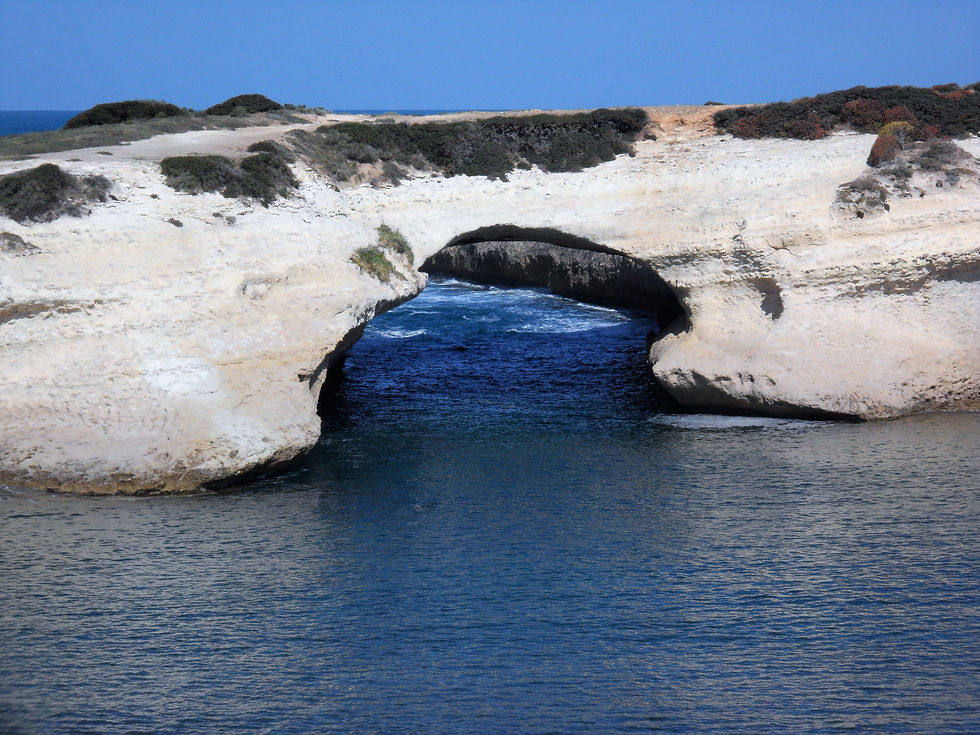An unusual and out of season Sardinia
- Angelo e Adele
- Feb 28, 2019
- 3 min read
Updated: Jan 17, 2023
Today we tell you about a trip we made by minibus in April 2016 and organized by one of our trusted tour operators, Planet Viaggi. The itinerary developed in central-south-western Sardinia, from Cagliari, where we gathered from various parts of Italy, up to Oristano and Orgosolo. We will try to give you an idea of the trip without following the chronological order but hopping here and there; looking on the map you will realize how much the places visited are scattered over a fairly vast territory, which we covered in less than a week without getting tired. You may say: does it make sense to go to Sardinia in April, without being able to swim in the sea? We answer yes, of course, and to convince you we start from the most beautiful seaside places we have visited, and which certainly cannot be enjoyed with this freedom in summer. The first place is S'Archittu (the arch), a beautiful promontory with a beach, where we found a beautiful panoramic road that can be practiced in a wheelchair:







We found another beautiful walk on the sea in Nèbida, near Iglesias:


A nice deviation inside led us to visit Orgosolo, where we could see the murals painted on the houses and we had lunch outdoors in an agritourism company managed by a shepherds cooperative, with the companions sitting on tree trunks and all of us who ate the sheep and pork meat that was served to us in wooden trays (both fantastic!):



And another fundamental step in the knowledge of Sardinian culture was a visit to the Museum of Mediterranean Masks in Mamoiada (http://www.museodellemaschere.it/) where specimens from Sardinia and other Mediterranean countries are collected:


Let's go back to the sea, or rather to an artistic activity that draws its nourishment from the sea. We are talking about the workshop of Chiara Vigo, who on the island of Sant'Antioco carries on with difficulty and in solitude the collection, transformation and weaving of the byssus, that is to say the filaments that protrude from the bivalve mollusk Pinna Nobilis and which are torn by hand (in apnea) and then worked up to make a fabric. The works, which are not for sale, are exhibited in a laboratory museum that we were able to visit. For further information and illustrations, please refer to the site https://www.chiaravigo.it/:




Not far from Sant'Antioco we visited Tratalias, a beautiful example of an ancient village restored and recovered for the enjoyment of contemporaries. The most striking building is the Roman Pisan Basilica of the thirteenth century:



In Barumini we visited the beautiful residence of the Zapata family, built at the end of the 16th century by don Azor, an alcalde from Cagliari, over the remains of a nuraghe. Since 2006, the Spanish residence has been a museum complex, called Casa Zapata (https://www.sardegnaturismo.it/it/esplora/casa-zapata). Here are some images that illustrate the path on walkways with a transparent bottom, which allow you to see the underlying remains of the nuraghe:



We did another good encounter with Sardinian gastronomy at Oristano, at Peschiera Pontis, an aquaculture establishment that also offers an excellent fish restaurant service and where we tasted a delicious bottarga:


And we did not miss even a visit to the Serbariu mine, near Carbonia. It is an old coal mine, transformed into the Italian center of coal culture, a real museum structure that allows you to visit the tunnels where the mining of the mineral took place and to see the finds (objects, photographs, various documents ) which testify to the very hard life of the miners (https://www.museodelcarbone.it).




We completely change the atmosphere and move to Sèneghe, in the laboratory of Raimondo Usai, a musician who produces and plays the instruments of the Sardinian tradition, using materials offered by nature such as cane, pumpkin, cork, bovine horn, but also wax. bees, goat skin and pig's bladder (http://www.urm-sonosdesardigna.com):



We close this post about our experience in Sardinia with a visit to Cagliari, a city that is not very easy because it is full of climbs and descents in its historic center; we still managed to visit the Cathedral:




going around the center we saw the Elephant Tower and the San Pancrazio Tower:



Moving away from the historic center of Cagliari, a look from above at the Molentargius lagoon, a wetland that became a regional natural park in 1999 (http://www.parcomolentargius.it/):


At this point we just have to say goodbye to Sardinia, hoping to return one day or another to discover other special and interesting things like those we have tried to illustrate to you.

Comments